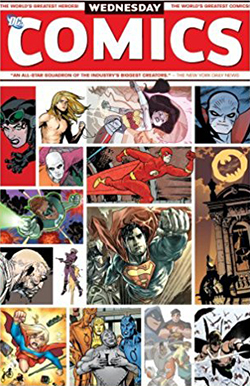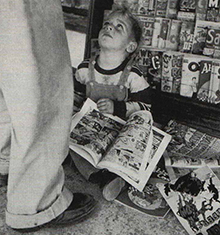Marc Alan Fishman: The Push of the Pull Box
As a rite of passage to become an official “Comic Book Nerd,” the pull box subscription is a near-impossible-to-ignore piece of the puzzle. For those playing along at home: the other parts include strong unwavering opinions you’re willing to argue over until your death, an ability to rattle off superhero minutiae without the use of Wikipedia, and typically a small collection of not-always-well-fitting graphic tee shirts. But I digress.
The pull box, for the uninitiated, is a service wherein a customer subscribes to weekly comics, and are held by their local comic book store for purchase. Every store does this a little different, but the big takeaways remain fairly standard: Pull box subscribers are offered a bit of a discount (often progressively increasing with order size) and are usually honor bound to come in and “clean out the box” as often as they’re able to.
 For perspective, I asked my own local comic book retailer (Joe Bullaro of The Zone in Homewood, IL) about pull boxes, and he put it quite succinctly:
For perspective, I asked my own local comic book retailer (Joe Bullaro of The Zone in Homewood, IL) about pull boxes, and he put it quite succinctly:
“I couldn’t imagine a store succeeding without a pull service… but I think many stores can fail because of one. “
For the store, pull boxes are mostly guaranteed sales. When customers are engaged with their store, and the current draw of monthly titles, there’s a wonderful symbiotic relationship. Back in my subscription days, a weekly trip to the comic shop was one looked forward to as seeing a good friend. Witty banter about what was occurring in the books I followed locked in step the way one might gab about their favorite TV shows. Each issue an episode. Each story arc picked apart for organic and passionate discussion. As Joe would denote to me “…it’s a community. It creates a bond between a customer and their store.” Loyalty feeding into prosperity.
But the pull box system is not always a box of roses. Joe was quick to add “…people abandon 100’s of dollars of books and don’t [always] communicate [their] reasons.” While some stores combat this by tying customers’ boxes to an on-file credit card… smaller stores know doing so limits customer’s desire to be officially subscribed to anything. Call it a fear of commitment. So it becomes a double-edged sword. Attempt to guarantee that pull boxes are clean, and potentially carve away swatches of your buying public. Even in my quaint little suburb, a comic fan is not necessarily limited to a single store to procure their fiction.
In addition to the potential fallout of customers who choose to inexplicably abandon their boxes, comes the actual work involved at the store to maintain the boxes in the first place. Every subscription to a book comes with a two-month ordering window. The book sits outside the regular order the store may keep for their off-the-shelf offerings. This means, for example, ordering 50 copies of Detective Comics to fulfill 40 different pull boxes, and keep 10 issues on the shelf for new comic book day when the issue arrives. And if the book is popular, like Detective Comics is, well, this is perfectly fine. But place your order on a more obscure title (even one from Marvel or DC) and you now place a bet: that your subscriber will buy the book, and if they don’t, placing it on your shelf isn’t taking up space a better book might inhabit.
 And then, of course, there comes the issue of annuals, double-drops, mini-series, new creative teams, or the dreaded crossovers. A fan of Green Lantern may be faced with a dozen options in a given month. And they need to commit two months in advance to ensure what they want is held back for them. It’s a dangerous game when the love of a character or book begins to wane.
And then, of course, there comes the issue of annuals, double-drops, mini-series, new creative teams, or the dreaded crossovers. A fan of Green Lantern may be faced with a dozen options in a given month. And they need to commit two months in advance to ensure what they want is held back for them. It’s a dangerous game when the love of a character or book begins to wane.
A few years ago, I made the choice to stop being a weekly subscriber. Faced with a less-than-enthusiastic opinion of the constant cycling of Epic Crossover, New Series Debut, Dwindling Sales, Book Cancellation, Repeat, I ultimately decided my comic purchases should be curtailed to graphic novels and indie titles procured at conventions I attended. While I have never personally abandoned a pull box before, I have been guilty of racking up massive back issues of books I slowly grew tired of. Wednesday Comics, Countdown to Final Crisis… thy name is mud.
So, where to leave the debate? Like so many things in this world, there’s a spectrum between black and white. As a necessary evil, the pull box can keep a store open perhaps almost as often it can wind up a debtor’s downfall. As a means to create a community and store culture, it can unite masses under common interests, or create the sparkling debate that ingrains a base of customers to their local store.
For me, it’s a matter of maturity and conservatism that prevents me from being a card-carrying member anymore. But I’d be lying if I said I didn’t miss walking into a shop, to be greeted warmly with a fresh pile of books awaiting my geeky eyes.













